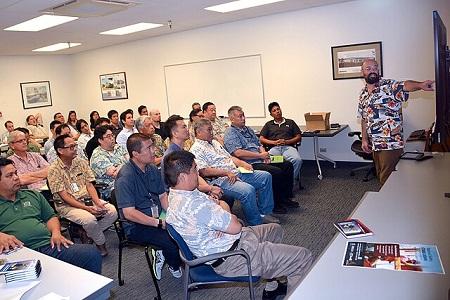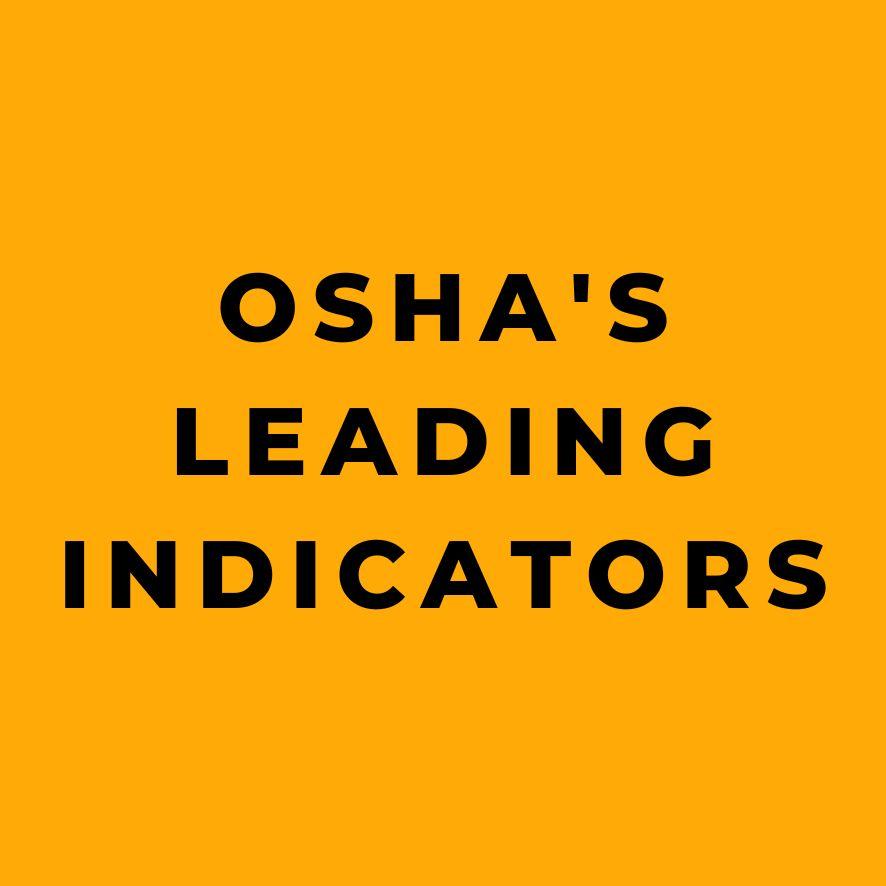Introduction
This guide is based on OSHA’s Leading Indicators Document.
In an era where workplace safety is paramount, a reactive approach often takes center stage, relegating proactive measures to a supporting role. This guide aims to shift this paradigm by delving into the use of OSHA’s leading indicators for preemptive safety management. Unlike traditional lagging indicators, which serve as a post-incident analysis tool, leading indicators offer foresight—providing key insights that allow organizations to act before accidents occur. This guide walks you through understanding these indicators, their inherent advantages, and how to implement them effectively using the SMART criteria—Specific, Measurable, Accountable, Reasonable, and Timely.
The significance of this shift can’t be overstated. In many organizations, safety is seen primarily through the lens of compliance, often driven by regulations and the fear of penalties. But leading indicators open up new vistas, linking safety not just to compliance but also to broader organizational goals like employee engagement, operational efficiency, and even profitability. By reading this guide, you’ll gain an understanding of the multi-faceted advantages that come from a well-implemented leading indicator program, which can transcend mere regulatory obedience to benefit your entire organization.
The content of this guide is structured to offer a comprehensive overview of the subject matter. It begins with an exploration of what leading indicators are and why they are vital tools for change. Next, it moves into the tangible and intangible benefits, highlighting how these indicators not only help in hazard prevention but also play a role in employee morale and bottom-line improvements. You’ll also get a deep dive into the characteristics that make these indicators effective, understanding the nuances of setting them up using the SMART criteria.
We recognize that theory without practice is incomplete. Therefore, this guide offers pragmatic advice on implementing leading indicators in your organization, detailing the approaches you can take—whether you’re looking to track existing data, control identified hazards, or improve safety program elements. Concrete examples are provided, outlining the steps involved from choosing your leading indicators to tracking and evaluating their effectiveness.
In conclusion, the guide serves as a valuable resource for anyone interested in making a seismic shift from a reactive to a proactive safety culture. We invite you to delve in, absorb the information, and arm yourself with the knowledge needed to usher in a new era of workplace safety—creating environments that are not just compliant but are also safer, more efficient, and conducive to overall organizational success.
Understanding Leading Indicators
Understanding what to look for is the first step toward prevention. This section will demystify the concept of leading indicators in workplace safety. We’ll explore how they serve as early-warning signals, enabling organizations to act before accidents happen, unlike lagging indicators that only offer post-incident analysis. Leading indicators include:
- Employee safety training participation
- Hazard reporting and corrective actions
- Safety inspection frequency
- Safety audits and program evaluations
Leading indicators drive change by revealing problems so employers can take corrective action before incidents happen. Lagging indicators show past performance but don’t explain how to improve. Effective programs use both, with leading indicators predicting incidents and lagging indicators measuring effectiveness.
Benefits of Leading Indicators
What good is knowledge if it doesn’t benefit your organization? Here, we’ll discuss the tangible and intangible benefits of implementing leading indicators. These advantages go beyond mere compliance, extending to facets like employee morale, financial savings, and operational efficiency.
Leading indicators offer many benefits:
- Prevent worker injuries and illnesses
- Reveal program weaknesses
- Identify hazards needing control
- Demonstrate safety commitment
- Improve organizational performance
- Reduce costs associated with incidents
By finding and fixing hazards before incidents occur, leading indicators help create a safer, more responsible workplace while improving the bottom line.
Characteristics of Effective Leading Indicators
Setting up leading indicators is not just about choosing any metric. In this section, we’ll outline the SMART criteria, a set of guidelines that ensure the chosen indicators actually make a meaningful impact. This will help you set up indicators that are actionable and insightful.
Effective leading indicators follow SMART criteria:
- Specific: Targets a clear action for controlling a hazard or improving a program area.
- Measurable: Presented numerically to reveal trends over time.
- Accountable: Tracks an item relevant for achieving the goal.
- Reasonable: Sets an achievable goal.
- Timely: Allows tracking at a useful frequency to identify meaningful trends.
Using Leading Indicators
Employers can use leading indicators in three main approaches:
- Track existing data to achieve a safety goal
- Control an identified hazard
- Improve a safety program element
Approach 1: Using Existing Data
Employers may already collect useful data that can become a leading indicator. For example, tracking employee attendance at mandatory quarterly safety training could help ensure adequate training. Steps include:
- Choose the leading indicator based on existing data.
- Set a measurable goal, like 100% attendance.
- Track progress periodically and act if not meeting the goal.
- Evaluate the goal over time and adjust as needed.
Approach 2: Controlling Hazards
Leading indicators can help control workplace hazards identified through assessments. For example, to reduce slips and falls, an employer could track completion of daily floor inspections and cleaning on the assembly line. Steps include:
- Select a leading indicator to control the hazard. Start by identifying top hazards through injury log reviews, hazard assessments, and input from workers. Prioritize the hazards with the greatest potential for harm.
- Set a measurable goal, like daily cleaning.
- Implement the indicator and collect data.
- Review periodically and adjust if incidents don’t decline as expected.
Approach 3: Improving Program Elements
Leading indicators can also measure implementation of recommended safety program practices, like management leadership, training, and communication. For example, to demonstrate commitment, management could give safety updates at monthly staff meetings. Steps include:
- Choose an indicator to improve a program area.
- Set a measurable goal, like monthly updates.
- Implement the indicator and track progress.
- Assess over time and adjust as needed to improve.
OSHA Recommended Safety Program Practices
OSHA outlines core safety program elements that exemplary programs incorporate. Leading indicators can measure implementation of recommended practices for each element, revealing areas for improvement.
Here are the core safety program elements that exemplary programs incorporate:
Management Leadership
Strong management leadership and commitment to safety is fundamental for any successful program. Leaders must actively demonstrate their commitment through direct actions and allocation of resources. Leading indicators can track management safety activities and commitment levels.
- Communicate safety commitment
- Define program goals
- Allocate resources
- Expect performance
Leading indicators could include:
- Managers attending worker safety training
- Frequency of management safety discussions
- Timeliness resolving worker hazard reports
Worker Participation
Actively engaging workers in the safety program improves motivation, hazard reporting, and overall workplace safety culture. Management should encourage involvement, provide safety information freely, and remove barriers to participation.
- Encourage involvement
- Remove barriers
- Provide safety information
- Invite input on program
Leading indicators could include:
- Worker participation in safety committees
- Completion of hazard inspection checklists
- Safety perception survey results
Hazard Identification and Assessment
Identifying and assessing hazards through inspections, investigations, worker reports, and maintenance reviews allows targeting resources to highest risk areas. Leading indicators should track how well hazard identification practices are implemented.
- Inspect the workplace
- Investigate incidents (root cause analysis should be included in investigations).
- Identify health hazards
- Assess risks
Leading indicators could include:
- Preventive maintenance work order completion
- Timeliness of incident investigations
- Inspection frequency
Hazard Prevention and Control
Implementing effective hazard controls and confirming their effectiveness is crucial for risk reduction. Leading indicators here can track if appropriate controls are in place and being used.
- Identify control options
- Implement controls
- Confirm effectiveness
Leading indicators could include:
- Hazards abated on day identified
- Use of safe work permits
- Audit findings corrected on time
Education and Training
Ongoing safety education and training is the foundation of any good safety program. Leading indicators should track program participation and effectiveness at teaching workers to recognize and control hazards.
- Conduct program training
- Train managers on responsibilities
- Train workers on hazard controls
- Cover special work needs
- Get worker feedback to improve training engagement and relevance.
Leading indicators could include:
- Training session participation rates
- Training comprehension surveys
- Mandatory training completion

PEARL HARBOR-HICKAM, Hawaii (May 8, 2017) As part of Occupational Safety and Health Administration (OSHA) National Safety Stand-Down to Prevent Falls in Construction, Naval Facilities Engineering Command Hawaii (NAVFAC) Hawaii Safety Office coordinated with NAVFAC Headquarters Mishap Prevention and Hazard Abatement Shawn Smith to present Fall Awareness and Designing Fall Protection into projects to command designers, program managers, and design managers, May 8 at the CI Conference Room, Joint Base Pearl Harbor-Hickam. (U.S. Navy photo by Denise Emsley, NAVFAC Hawaii Public Affairs/Released)
Program Evaluation and Improvement
Continual program evaluation and improvement is key to advancing safety performance. Leading indicators can assess how well the program is implemented, identify gaps, and show where progress is being made.
- Monitor performance
- Verify program implementation
- Identify opportunities to improve
Leading indicators could include:
- Inspection frequency
- Lagging indicator rate improvements
- Annual program goals achieved
Communication and Coordination
Clear communication and coordination between departments, organizations, management, and workers helps connect the entire safety program. Leading indicators can measure engagement levels across all parties.
- Establish effective communication
- Coordinate across departments and organizations
Leading indicators could include:
- Safety discussions between contract workers and supervisors
- Pre-work hazard training for contract workers
- Audits of contractor safety program compliance
Implementing Leading Indicators
Follow these steps when implementing leading indicators:
- Identify problem areas to prioritize, considering hazards, injuries, and program weaknesses.
- Set measurable goals for the issues selected.
- Choose appropriate leading indicators to reach the goals.
- Communicate about the indicators and goals with workers.
- Collect and track data on the leading indicators.
- Review periodically and respond to trends.
- Adjust indicators and goals over time as needed.
Start with one or two manageable indicators, customize for your needs and abilities, and expand the program gradually. Patience is required when using leading indicators to improve safety culture. Consistent tracking, review, and adjustments will produce long-term improvements.
Best Practices for Safety Training Programs
Effective safety training is essential for educating workers on recognizing and controlling hazards. Follow these best practices:
- Use adult learning principles suited to trainees’ needs and experience.
- Blend classroom, online, hands-on, and simulation training methods.
- Evaluate and update programs regularly using participant feedback and improvements in safety research and technology.
- Align training content with hazard assessments and inspections.
- Verify training comprehension, not just attendance.
- Provide training in languages workers understand.
- Make training dynamic, practical and engaging, not just lectures.
- Use train-the-trainer programs to educate internal safety coaches.
Proper training programs not only educate workers on safety procedures but also strengthen safety culture. Leading indicators measuring training participation, comprehension, and updating can help gauge program effectiveness.
Conclusion
In an organizational landscape where reactive safety measures are often the norm, the imperative to shift toward a proactive approach has never been more evident. OSHA’s leading indicators serve as the linchpin for this transformation. They enable organizations to identify, analyze, and act upon potential safety hazards before they escalate into harmful incidents. With the right set of indicators, carefully selected and calibrated using the SMART criteria, companies can create a safety culture that’s not just compliant but also fundamentally improves employee wellbeing, operational efficiency, and even the bottom line.
Moreover, the integration of leading indicators into existing safety programs offers a multi-faceted benefit, enhancing not just hazard prevention but also employee engagement and managerial commitment. From utilizing existing data to control hazards, to continually refining program elements, the adaptive nature of leading indicators allows for their application across a wide array of operational contexts and industrial sectors. Organizations can seamlessly align them with OSHA’s recommended safety practices to build a safety program that’s as comprehensive as it is effective.
As we move into an increasingly complex work environment, laden with both visible and hidden risks, the role of predictive safety measures like leading indicators will only grow in importance. By adopting a focused yet flexible approach, starting small and then incrementally expanding, organizations can embed a culture of safety that evolves with them. Leading indicators are not just tools for risk mitigation; they’re instruments for fostering a more responsible, aware, and ultimately, safer workplace. Through patient implementation and consistent tracking, any organization can harness the full power of leading indicators to construct a more secure and successful work environment.
- OSHA Leading Indicators: OSHA Leading Indicators
- OSHA Recommended Practices: OSHA Recommended Practices
- Susan Harwood Training Grants: Susan Harwood Training Grants
- OSHA Training Institute Education Centers: OSHA Training Institute Education Centers
- Best Practices for Safety Training Programs: Best Practices for Safety Training Programs










